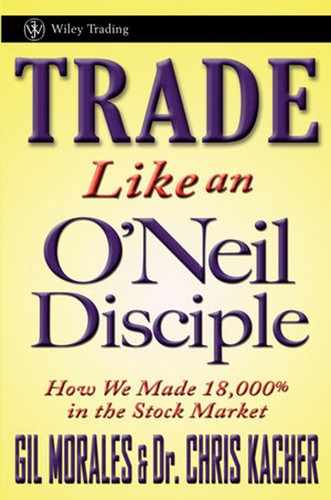1.7. DEALING IN BIG STOCKS AND INSTITUTIONAL SPONSORSHIP
Owning the biggest winners in the market means owning the stocks that institutions are piling into, and O'Neil sees modern-day mutual funds, hedge funds, and pension funds, and other members of the "institutional investor zoo," as akin to the "pools" and "trusts" of Jesse Livermore's and Richard Wyckoff's era. It is the accumulation of stock by large institutions that produces the huge price moves upon which O'Neil methodologies seek to capitalize. And the smart institutions, such as those with the better research and stock selection skills, are the ones in whose footsteps you want to follow. O'Neil asserts, "It takes big demand to push up prices, and by far the biggest source of demand for stocks is institutional investors, such as mutual funds, pension funds, hedge funds, insurance companies, [etc]. A winning stock doesn't need a huge number of institutional owners, but it should have several at a minimum." O'Neil continues, "[Diligent investors] look for stocks that are held by at least one or two of the more savvy portfolio managers who have the best performance records" (How to Make Money in Stocks, 4th ed. [New York: McGraw-Hill, 2009], 193–194).
Knowing where the smart money is moving is central to O'Neil's methodology, and understanding the quality of institutional sponsorship coming into a stock is no different from what Richard Wyckoff advised when he wrote, "It is important to know whether large operators, inside interests, pools, or the public dominate the market for a certain security or group." Wyckoff went on to explain, "The reason this is so important is as follows: A combination of bankers will seldom be found on the long side of the market unless they expect a pronounced change in security market conditions in the near future. Their own purchases, therefore, are an indication of probable betterment. When a pool takes hold, it is usually in a certain one or a few issues which are likely to be favorably affected by developments known to a few but not generally known" (How I Trade and Invest in Stocks & Bonds [New York: The Magazine of Wall Street, 1924], 183).
O'Neil's unique and deep understanding of the institutional investor and the implications of institutional sponsorship is founded in the experience he has had advising some of the largest and most successful institutional investors on the planet. It is this understanding that generates what we have dubbed The Big Stock Principle that drove O'Neil's thinking in any market cycle. Knowing which stocks represented the cutting edge of developments driving any particular economic, and hence market, cycle means knowing where institutional investors "have to be" with respect to positioning their portfolios. When institutional investors start shoveling money into stocks that they "have to be" invested in, this fuels tremendous upside price moves in those stocks, and it is what makes them "Big Stocks." It is a central tenet of O'Neil-style investing.
